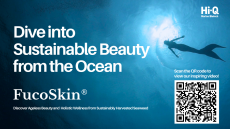Chemicals Strategy for Sustainability to have ‘significant consequences’ on entire value chain: BASF
![Downstream users of chemicals, including beauty and personal care manufacturers, will start to face challenges if the chemical toolbox shrinks and a zero-tolerance approach is taken on non-compliance [Getty Images]](/var/wrbm_gb_food_pharma/storage/images/_aliases/wrbm_large/publications/cosmetics/cosmeticsdesign-europe.com/article/2021/12/15/european-green-deal-chemicals-strategy-for-sustainability-beauty-and-cosmetics-impact-significant/13097923-1-eng-GB/European-Green-Deal-Chemicals-Strategy-for-Sustainability-beauty-and-cosmetics-impact-significant.jpg)
Back in December 2019, the European Commission (EC) unveiled its European Green Deal – a far-reaching strategy aimed at driving Europe towards becoming the first climate-neutral continent by 2050, enshrining climate-neutrality into law, and bolstering efforts against single-use plastics, slashing carbon emissions and building circular business models.
And an important part of the European Green Deal, highly relevant to the beauty and personal care market, was the Chemicals Strategy for Sustainability which was adopted in October 2020 and aimed to phase out the most harmful substances and simplify the risk association process.
Opportunities and challenges ahead for industry
Speaking to attendees at last month’s SCS Formulate 2021 in Coventry, UK, Andrea Tomlinson, marketing manager for personal care at BASF, said the Chemicals Strategy specifically would have a “huge impact” on the cosmetics industry in Europe and beyond, creating both opportunities and challenges moving forward.
“The Chemicals Strategy for Sustainability has two main pillars. The first is using innovation to enable the transition to safe and sustainable chemicals, and this can be seen as an opportunity,” Tomlinson said during a presentation at the SCS Formulate Sustainability Studio.
“The second [pillar] is the regulation and enhancing the health of humans and the environment, and this is maybe a bit more challenging,” she said.
“…What we’re aware of is chemical policy and legislation has to move just as quickly to keep pace with the changes that are needed.”
Within the regulatory framework that accompanied the European Green Deal and Chemicals Strategy for Sustainability, Tomlinson said the European Commission (EC) wanted to simplify and consolidate the risk assessment process and adopt a zero-tolerance approach for non-compliance. Industry concerns and potential challenges, therefore, related to a transition away from the “standard industry approach” of conducting risk assessments – looking at products and their use and considering exposure as a key element – and the rise of imports and e-commerce posing problems with non-compliance, she said.
‘Generic’ approach to risk assessment
“What we’re looking at is the introduction of a generic approach for risk management of consumer products,” Tomlinson said. “This means completely abandoning scientific principles for risk assessment by neglecting the exposure element. Where historically we have already calculated risk, based on hazard times exposure, that exposure element is lost and going forward we shouldn’t only consider hazard.”
If such generic risk assessment approaches became widespread, she said many chemical substances could be deemed hazardous or of high concern, even entire groups of chemicals, and as such the cosmetics industry would lose access to materials, many of which contributed in a “very positive way” to the overall Green Deal. It could also cause “professional disadvantages” for industry producers in Europe, she said.
Around 200 substances of very high concern (SVHC) were already due to be phased out under the Strategy, but there were a further 4,000 substances in the European Chemicals Agency’s (ECHA) database that had hazards associated with them that could end up being brought into a SVHC status with this new hazard assessment approach, she said.
“With all these changes, the chemical toolbox will shrink; many substances will be affected. We’re thinking of feedstocks, intermediates, and end products. It will really affect everything within the whole production process. So, we see that the Chemicals Strategy for Sustainability has significant consequences along the value chain. Many chemicals may disappear from the market.”
‘High focus’ from industry needed moving forward
Tomlinson said this could mean wider supply chains were disrupted and downstream users of chemicals affected, including personal care manufacturers, because of a reduced number of materials available.
“And its not just European businesses that will be affected, because so many manufacturers of cosmetic products are global companies. This is going to have a knock-on impact, definitely on the UK market but also on any product imported and exported into Europe,” she said.
![Imports, exports and e-commerce business will come under zero-tolerance scrutiny as part of the Chemicals Strategy for Sustainability [Getty Images]](/var/wrbm_gb_food_pharma/storage/images/_aliases/wrbm_large/media/images/warehouse_distribution_shipping_deliveries_imports_exports_beauty_cosmetics_personalcare_brands_manufacturers_network_europe_global_international_business/13098133-1-eng-GB/warehouse_distribution_shipping_Deliveries_imports_exports_beauty_cosmetics_personalcare_brands_manufacturers_network_Europe_global_international_b.jpg)
The extensive import-export market and rising world of e-commerce was therefore a cause for concern given the EC was taking a zero-tolerance approach on the framework, she said.
“There’s really the necessity for all companies to start looking at their production strategy for materials which are manufactured or imported into Europe.”
The Chemicals Strategy for Sustainability was clearly a “topic of high importance” and “high priority” for the beauty and personal care industry, Tomlinson said, and would remain a “high focus” for BASF and wider industry for “many years to come”.
Because of this, the supply major was working closely with other organisations in the chemicals and cosmetics industries and would continue to work on advocacy where any areas of concern were identified, she said.
However, as industry moved forward collaboratively, she said there were also plenty of “positives” and “opportunities” to be had operating under the European Green Deal and its Chemicals Strategy for Sustainability, with the right investment.
Positive impact? A ‘further push’ for sustainable beauty
Christian Somigliana, director of market development for personal care Europe at BASF, said the positive side of the European Green Deal was that it would act as a “further push” for industry to continue its environmental and sustainability goals moving forward.
For BASF, Somigliana said the Deal had been the push behind an internal project called Green Balance that considered closely all key elements driving company choices around biobased materials, sustainable sourcing, biodegradability, and carbon footprint, among other aspects.
Importantly, he said the European Green Deal was now also guiding innovation, alongside wider market trends.
“We do believe the market trends are as important as the regulation – we have to deliver what the market wants. The aim is, in the mid- to long-term, to innovate with four main pillars: sustainable product alternatives, natural and biodegradable polymers, biosurfactants, and eco-friendly UV filters,” he said.
The other point was outcome, he said, with all decisions and innovations made to help achieve the wider goal of lowering overall carbon footprint and impact on the climate.
Earlier this year, the Center for International Environmental Law (CIEL) told CosmeticsDesign-Europe the Chemicals Strategy for Sustainability had the potential to be a global game-changer if concrete actions and legislative proposals were built out into something meaningful.
![Many substances may be affected by a more generic approach to risk assessment [Getty Images]](/var/wrbm_gb_food_pharma/storage/images/_aliases/wrbm_large/media/images/lab_laboratory_risk_assessment_safety_control_quality_personalcare_beauty_cosmetics_formulation_trends_supplychain_innovation/13098117-1-eng-GB/lab_laboratory_risk_assessment_safety_control_quality_personalcare_beauty_cosmetics_formulation_trends_supplychain_innovation.jpg)
![Perfluoroalkyl and Polyfluoroalkyl Substances (PFAs), largely used in non-stick and water-resistant items like cookware and clothing, but also found in beauty and personal care products, were being increasingly detected as environmental pollutants in groundwater and soil [Getty Images]](/var/wrbm_gb_food_pharma/storage/images/_aliases/wrbm_medium/publications/cosmetics/cosmeticsdesign-europe.com/article/2023/01/26/pfas-ban-in-european-union-proposed-by-five-national-authorities-to-be-evaluated-by-echa/16117178-1-eng-GB/PFAs-ban-in-European-Union-proposed-by-five-national-authorities-to-be-evaluated-by-ECHA.jpg)
![The five companies have been recognised for their environmental leadership across climate change, forests and water scarcity - a status only 12 global companies achieved in 2022 [Getty Images]](/var/wrbm_gb_food_pharma/storage/images/_aliases/wrbm_medium/publications/cosmetics/cosmeticsdesign-europe.com/article/2023/01/11/cdp-a-list-2022-features-beiersdorf-firmenich-kao-l-oreal-and-lvmh-as-triple-a-scores-for-environmental-leadership/16074266-1-eng-GB/CDP-A-List-2022-features-Beiersdorf-Firmenich-Kao-L-Oreal-and-LVMH-as-Triple-A-scores-for-environmental-leadership.jpg)
![The animal welfare charity hopes its REACH revision proposal drives wider uptake and acceptance of animal-free new approach methodologies (NAMs) for cosmetics safety assessment [Getty Images]](/var/wrbm_gb_food_pharma/storage/images/_aliases/wrbm_medium/publications/cosmetics/cosmeticsdesign-europe.com/article/2022/10/26/humane-society-international-reach-revision-proposal-calls-for-echa-procedural-technical-and-structural-change/15885212-1-eng-GB/Humane-Society-International-REACH-revision-proposal-calls-for-ECHA-procedural-technical-and-structural-change.jpg)
![Business continuity models have to change gears, integrating the very real and 'permanent crisis' facing the world today [Getty Images]](/var/wrbm_gb_food_pharma/storage/images/_aliases/wrbm_medium/publications/cosmetics/cosmeticsdesign-europe.com/article/2022/10/12/beauty-must-respond-to-climate-crisis-with-ethical-integrity-of-supply-chains-says-sir-jonathon-porritt-at-ifscc-2022/15845378-1-eng-GB/Beauty-must-respond-to-climate-crisis-with-ethical-integrity-of-supply-chains-says-Sir-Jonathon-Porritt-at-IFSCC-2022.jpg)
























